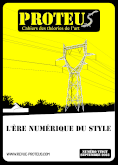Que peuvent les machines nous apprendre du style ?
Abstract
 Télécharger l’article
Télécharger l’article
Paru dans : Proteus n°20

Cet article propose quelques pistes de réflexion sur la notion de style dans sa relation aux outils et méthodes de l’« Intelligence Artificielle » appliquées à la création artistique. Cette réflexion est conduite dans une double perspective : artistique et technique d’une part, et esthétique et épistémologique d’autre part. Elle se concentre en particulier sur la question des taxonomies sur lesquelles se basent les mécanismes de reconnaissance, d’apprentissage et de génération d’artefacts artistiques. Ces taxonomies peuvent être définies de diverses manières plus ou moins autonomes, principalement selon le paradigme connexionniste. Nous nous intéressons en particulier à l’aspect fonctionnel de ce paradigme, le « réseau de neurones artificiel », qui permet de reconnaître et de générer, à partir d’un jeu réduit de critères initiaux, des caractères morphologiques complexes, qui font sens d’une manière intuitive pour l’humain. Nous posons à travers cet examen quelques hypothèses sur les raisons de l’efficacité de ces techniques, en rapprochant ces taxonomies – qui s’élaborent et « se tiennent » sans le besoin d’une définition préalable explicite – de la notion proposée par l’épistémologue Richard Boyd de « grappes de propriétés homéostatiques » et la mettons en relation avec la définition du style que donnent Deleuze et Guattari autour de la notion de « consistance ». Pour conclure, nous proposons quelques interrogations et pistes de réflexion sur les contraintes et conditionnements sur l’expression artistique qu’implique l’usage de ces systèmes dans une pratique artistique.
Mots-clés : Intelligence artificielle — Connexionnisme — Apprentissage automatique — épistémologie — Poïétique
This article proposes some lines of thought on the notion of style in its relation to the tools and methods of "Artificial Intelligence" applied to artistic creation. This reflection is conducted from a double perspective: artistic and technical on the one hand, and aesthetic and epistemological on the other. It focuses in particular on the question of the taxonomies on which the mechanisms of recognition, learning and generation of artistic artefacts are based. These taxonomies can be defined in various more or less autonomous ways, mainly according to the connectionist paradigm. We are particularly interested in the functional aspect of this paradigm, the "artificial neural network", which allows to recognize and generate, from a reduced set of initial criteria, complex morphological characters, which make sense in an intuitive way for humans. Through this examination, we put forward some hypotheses on the reasons for the effectiveness of these techniques, by bringing these taxonomies – which are elaborated and "held together" without the need for a prior and explicit definition – closer to the notion proposed by the epistemologist Richard Boyd of "clusters of homeostatic properties", and relate it to the definition of style given by Deleuze and Guattari around the notion of "consistency". To conclude, we propose some questions and avenues of reflection on the constraints and conditioning on artistic expression implied by the use of these systems in an artistic practice.
Keywords: Artificial intelligence — Connexionism — Machine learning — Epistemology — Poiesis








